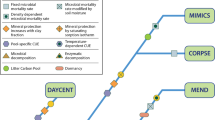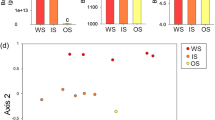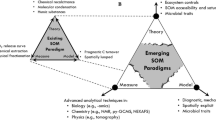Abstract
Carbon cycling models consider soil carbon sequestration a key process for climate change mitigation. However, these models mostly focus on abiotic soil processes and, despite its recognized critical mechanistic role, do not explicitly include interacting soil organisms. Here, we use a literature study to show that even a relatively simple soil community (heathland soils) contains large uncertainties in temporal and spatial food web structure. Next, we used a Lotka–Volterra-based food web model to demonstrate that, due to these uncertainties, climate change can either increase or decrease soil carbon sequestration to varying extents. Both the strength and direction of changes strongly depend on (1) the main consumer’s (enchytraeid worms) feeding preferences and (2) whether decomposers (fungi) or enchytraeid worms are more sensitive to stress. Hence, even for a soil community with a few dominant functional groups and a simulation model with a few parameters, filling these knowledge gaps is a critical first step towards the explicit integration of soil food web dynamics into carbon cycling models in order to better assess the role soils play in climate change mitigation.




Similar content being viewed by others
References
Lal R (2004) Soil carbon sequestration to mitigate climate change. Geoderma 123(1–2):1–22
Crowther TW et al (Nov. 2016) Quantifying global soil carbon losses in response to warming. Nature 540(7631):104–108
Todd-Brown KEO et al (Apr. 2014) Changes in soil organic carbon storage predicted by Earth system models during the 21st century. Biogeosciences 11(8):2341–2356
Smith J et al (Dec. 2010) Estimating changes in Scottish soil carbon stocks using ECOSSE. I. Model description and uncertainties. Clim Res 45:179–192
Hunt HW, Wall DH (2002) Modelling the effects of loss of soil biodiversity on ecosystem function. Glob Chang Biol 8(1):33–50
Handa IT et al (2014) Consequences of biodiversity loss for litter decomposition across biomes. Nature 509(7499):218–221
Todd-Brown KEO, Hopkins FM, Kivlin SN, Talbot JM, Allison SD (2012) A framework for representing microbial decomposition in coupled climate models. Biogeochemistry 109(1–3):19–33
McGuire KL, Treseder KK (2010) Microbial communities and their relevance for ecosystem models: decomposition as a case study. Soil Biol Biochem 42(4):529–535
Bardgett RD, Freeman C, Ostle NJ (2008) Microbial contributions to climate change through carbon cycle feedbacks. ISME J 2(8):805–814
Wieder WR, Bonan GB, Allison SD (2013) Global soil carbon projections are improved by modelling microbial processes. Nat Clim Chang 3(10):909–912
M. Heimann and M. Reichstein, Terrestrial ecosystem carbon dynamics and climate feedbacks. Nature, vol. 451, no. January, pp. 289–292, 2008.
Filser J et al. (2016) Soil fauna: key to new carbon models. pp. 565–582
Read DJ, Leake JR, Perez-Moreno J (2004) Mycorrhizal fungi as drivers of ecosystem processes in heathland and boreal forest biomes. Can J Bot 82(8):1243–1263
Smith J et al (2010) Estimating changes in Scottish soil carbon stocks using ECOSSE. II. Application. Clim Res 45:193–205
Sowerby A, Emmett BA, Tietema A, Beier C (Oct. 2008) Contrasting effects of repeated summer drought on soil carbon efflux in hydric and mesic heathland soils. Glob Chang Biol 14(10):2388–2404
Reinsch S et al (2014) Short-term utilization of carbon by the soil microbial community under future climatic conditions in a temperate heathland. Soil Biol Biochem 68:9–19
Starrett MC, Heleba DA, Wheeler AR (2003) Use of an ericoid mycorrhizal fungus to improve rooting and acclimation of difficult-to-root cultivars of rhododendron. J Am Rhododendron Soc 57(2):66–71
Crowther TW, Boddy L, Jones TH (2011) Outcomes of fungal interactions are determined by soil invertebrate grazers. Ecol Lett 14(11):1134–1142
Lehmann J, Kleber M (2015) The contentious nature of soil organic matter. Nature 528(7580):60–68
Dungait JAJ, Hopkins DW, and Gregory AS (2012) Soil organic matter turnover is governed by accessibility not recalcitrance. pp. 1781–1796
Rousk J et al (2010) Soil bacterial and fungal communities across a pH gradient in an arable soil. ISME J 4:1340–1351
Liang C, Balser TC (2010) Microbial production of recalcitrant organic matter in global soils: implications for productivity and climate policy. Nat Publ Gr 9(1):1
Treseder KK, Lennon JT (Jun. 2015) Fungal traits that drive ecosystem dynamics on land. Microbiol Mol Biol Rev 79(2):243–262
Maraldo K, Holmstrup M (53, 2010) Enchytraeids in a changing climate: a mini-review. Pedobiologia (Jena) (3):161–167
Martinsson S, Rota E, and Erséus C (2015) On the identity of Chamaedrilus glandulosus with the description of a new species 14:1–14.
Holmstrup M et al (2012) Increased frequency of drought reduces species richness of enchytraeid communities in both wet and dry heathland soils. Soil Biol Biochem 53:43–49
Lavelle P, Spain AV (2001) Soil ecology. Academics, Dordrecht, Netherlands
Gajda Ł, Gorgoń S, Urbisz AZ (2017) Food preferences of enchytraeids. Pedobiologia (Jena) 63:19–36
IPCC (Intergovernmental Panel on Climate Change) (2014) Climate change 2014: impacts, adaptation, and vulnerability.
Gorissen A et al (Oct. 2004) Climate change affects carbon allocation to the soil in shrublands. Ecosystems 7(6)
Peñuelas J et al (Dec. 2007) Response of plant species richness and primary productivity in shrublands along a north–south gradient in Europe to seven years of experimental warming and drought: reductions in primary productivity in the heat and drought year of 2003. Glob Chang Biol 13(12):2563–2581
Holmstrup M et al (2017) Long-term and realistic global change manipulations had low impact on diversity of soil biota in temperate heathland. Sci Rep 7:41388
Hawkes CV, Kivlin SN, Rocca JD, Huguet V, Thomsen MA, Suttle KB (2011) Fungal community responses to precipitation. Glob Chang Biol 17(4):1637–1645
Toberman H et al (2008) Summer drought effects upon soil and litter extracellular phenol oxidase activity and soluble carbon release in an upland Calluna heathland. Soil Biol Biochem 40(6):1519–1532
Dias ATC et al (2013) Traits underpinning desiccation resistance explain distribution patterns of terrestrial isopods. Oecologia 172:667–677
Franken O, Huizinga M, Ellers J, Berg MP (2018) Heated communities: large inter- and intraspecific variation in heat tolerance across trophic levels of a soil arthropod community. Oecologia 186(2):311–322
Lenaers M et al (2018) Links between heathland fungal biomass mineralization, melanization, and hydrophobicity. Microb. Ecol, Feb
Eklöf A, Ebenman BO (2006) Species loss and secondary extinctions in simple and complex model communities. J Anim Ecol 75(1):239–246
Berg M, de Ruiter P, Didden W, Janssen M, Schouten T, Verhoef H (2001) Community food web, decomposition and nitrogen mineralisation in a stratified Scots pine forest soil. Oikos 93:130–142
Scheu S (2002) The soil food web: structure and perspectives. Eur J Soil Biol 38:11–20
Berg MP, Bengtsson J (2007) Temporal and spatial variability in soil food web structure. Oikos 116(11):1789–1804
Eisenhauer N et al (2017) Priorities for research in soil ecology. Pedobiologia (Jena) 63:1–7
Funding
This study was financially supported by BOF (Bijzonder Onderzoeksfonds) and FSR (Fonds Spécial de Recherche) (both Special Research Funds) from Hasselt University and Namur University, respectively, under the research grant number BOF15DOCNA02.
Author information
Authors and Affiliations
Corresponding author
Ethics declarations
Conflict of Interest
The authors declare that they have no conflict of interest.
Electronic supplementary material
ESM 1
(DOCX 54 kb)
Rights and permissions
About this article
Cite this article
Reyns, W., Rineau, F., Spaak, J.W. et al. Food Web Uncertainties Influence Predictions of Climate Change Effects on Soil Carbon Sequestration in Heathlands. Microb Ecol 79, 686–693 (2020). https://doi.org/10.1007/s00248-019-01444-1
Received:
Accepted:
Published:
Issue Date:
DOI: https://doi.org/10.1007/s00248-019-01444-1




